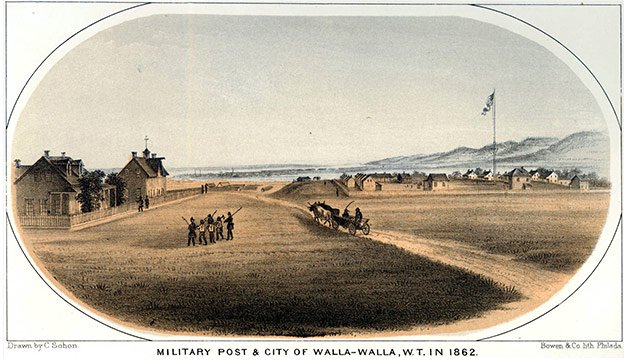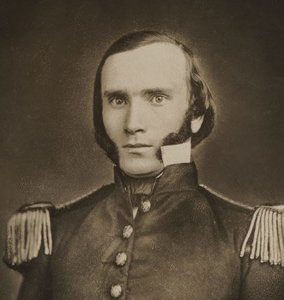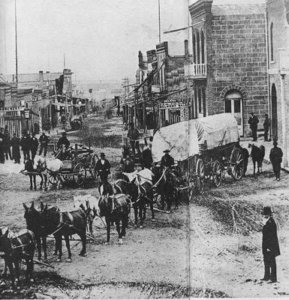Mullan Road History Conference, Historic Site Dedication, and Oregon Trail Tour Scheduled for May 3-5, 2019 In Walla Walla
The weekend of May 3-5, Walla Walla 2020 will be hosting the annual Mullan Road History Conference held each year somewhere between the Missouri and Columbia rivers along the historic wagon road linking the two waterways.
The conference will begin on Friday evening, May 3 with a reception for conference participants at Fort Walla Walla Museum, sponsored by Mullan Road Cellars, a Walla Walla winery. On Saturday, May 4, a full day of talks on the history of the Mullan Road will be presented at a meeting room at the District 140 transportation facility, ending with a catered dinner featuring keynote speaker John Mullan, who built the road with a 100-man crew from 1859-1862.
Sunday, May 5, will feature a morning bus tour of the Oregon Trail from Walla Walla to Wallula, which will also include other historic trails, beginning at 9 a.m. The tour will be followed by lunch in the Walla Walla University cafeteria, the dedication of the new Mullan Road Historic Site at 13th and Abadie at 1 p.m., and a living history performance at Fort Walla Walla Museum at 2 p.m.
Register Now
- To register online for the full conference, or selected events, register here.
- Mail-in registration is also available; download the registration form here.
- For more information, email ww2020@charter.net, or phone 509-629-2791.
Schedule of Events
Download the conference schedule here.
- Be sure to register by April 24th — or get your mail-in registration postmarked by April 24th — to be entered in a drawing for a lovely basket of books and booze. If you’ve already registered, your name is in the hat. Drawing will take place at Friday’s reception.
- We are excited to announce that students are FREE for the Sunday bus tour. Please email Renée Cebula to register. We need to know the number of people for the bus. Thank you!
- Finally, spring is a busy time in the wine country of Walla Walla. If you have not made arrangements for accommodations, please do so ASAP.
About The Mullan Road
In March of 1858, US Army Lt. John Mullan was given the task of building a wagon road from the steamship docks at old Fort Walla Walla on the Columbia River across the Rocky Mountains to the steamship docks at Fort Benton on the Missouri River, by way of the new fort at the town of Walla Walla.
The initial construction by Lt. Mullan and his crew began from Walla Walla in June of 1859 and was completed in October of 1860. In May, 1861, Mullan began rebuilding and improving portions of the route, and by August 1862, the 655 mile road, including the previously existing portion from Wallula to Walla Walla, was finally completed. The finished product, which became known as the Mullan Road, provided a route for pioneer families, miners, and the military between the two major rivers, and became the first engineered highway in the northwest.
Visitors to the new Mullan Road Historic site can follow the road through interpretive panels that will take them from:
- Old Fort Walla Walla on the Columbia River to the military fort in the town of Walla Walla,
- the new fort in Walla Walla to the Snake River crossing,
- the Snake River to the Spokane Valley,
- Spokane to the Coeur d’Alene Mission,
- Coeur d’Alene to Hell Gate/Missoula,
- Hell Gate to Mullan Pass/Helena,
- Mullan Pass to Sun River/Great Falls, and finally
- Sun River to Fort Benton on the Missouri River.
The Historic Site developed by Walla Walla 2020 on Thirteenth is at the corner of the original Fort Walla Walla military reservation. The route of the Mullan Road ran from the military fort on the current VA Medical Center grounds through the present penitentiary site, where a granite marker honoring the road was placed by the Washington State Historical Society in 1923. The marker has now been moved to the new historic site by the City of Walla Walla, to help honor the realization of the longstanding dream of President Thomas Jefferson for a Northwest Passage linking the continent from east to west.
Towns that sprang up along the route, including Helena, Montana, depended heavily on the Mullan Road for supplies and transportation to Walla Walla and the Columbia River. In 1866 a memorial by the Montana territorial legislature sitting in Helena pleaded for the road to be improved, and reminded the U.S. Congress of
“the necessity for a great national highway connecting the Missouri and Columbia rivers by a good and substantial wagon road, What was a wilderness now contains a large and rapidly increasing population, producing millions of bushels of grain and millions of dollars per annum in gold and silver. The opening of this road is of the greatest, most vital importance to the people of Washington, Idaho, and that portion of Montana lying west of the Rocky mountains; and in a military point of view, its value cannot be overestimated.”
The Montana legislature’s memorial goes on,
“From Jan. 1, to Nov. 15, 1866, 1500 head of horses have been purchased by individual miners at Walla Walla; 5000 head of cattle were driven from Walla Walla to Montana; 6000 mules have left the Columbia river and Walla Walla loaded with freight for Montana; 52 light wagons with families have left Walla Walla for Montana; 31 wagons with immigrants have come through from the States via the Mullan Road, a portion of whom settled in Walla Walla valley… not less than 20,000 persons have passed over the Mullan road to and from Montana during the past season; $1,000,000 in treasure has passed down through Walla Walla and Wallula during the same period.”
Since the portion of the wagon road from the steamship dock at Wallula to Walla Walla already existed as the Oregon Trail, the actual construction of the Mullan Road began in Walla Walla and proceeded north. The Sunday morning conference tour will use a bus provided by Walla Walla University to follow the route of the original Oregon Trail from the Whitman Mission to Wallula, later becoming a portion of the Mullan Road. At Wallula, participants will have an opportunity to walk an intact portion of the Oregon Trail as it approached the Columbia River.
 Daniel N. Clark is a retired lawyer. He coordinates the Walla Walla 2020 Historic Sites & Markers Project, and was a founder of the Living History Company at Fort Walla Walla Museum, and a new nonprofit called Walla Walla Historic Cemeteries. He has also authored a new book titled Historic Sites and Markers of Walla Walla County published by Walla Walla 2020.
Daniel N. Clark is a retired lawyer. He coordinates the Walla Walla 2020 Historic Sites & Markers Project, and was a founder of the Living History Company at Fort Walla Walla Museum, and a new nonprofit called Walla Walla Historic Cemeteries. He has also authored a new book titled Historic Sites and Markers of Walla Walla County published by Walla Walla 2020.





